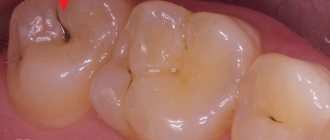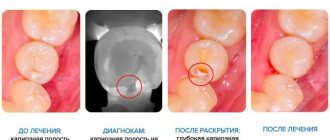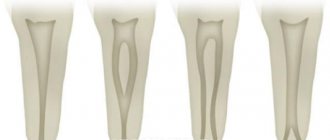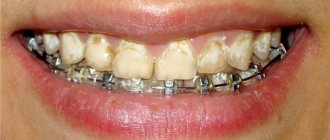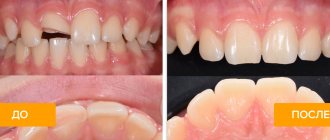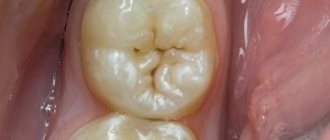Children are more susceptible to caries than adults. This is explained by various reasons: weak immunity, thin enamel, etc. Is it necessary to take preventive measures if baby teeth fall out anyway and permanent ones grow in their place? In this article we will answer this question and tell you what measures can prevent childhood caries.
In this article
- Methods for preventing caries in children
- Prevention of caries in young children
- Prevention of caries in preschool children
- Prevention of caries in school-age children
Caries develops due to the proliferation of cariogenic microbes in the mouth. They are present in the oral cavity of all adults; children can become infected with them from their mother through a kiss, pacifier or food. At the same time, the risk of developing this disease in childhood is quite high. This is due to a number of factors, including:
- Poor oral hygiene. Children brush their teeth reluctantly and poorly, especially if this process is not supervised by adults. Leftover food is a favorable environment for the growth of bacteria. The worse a child’s hygiene is, the more often he or she develops caries.
- Consumption of sweets in large quantities. Cariogenic microorganisms live off carbohydrates, so sweets that children eat very often contribute to the rapid spread of bacteria and the appearance of carious lesions.
- Weak enamel. Milk teeth and newly emerging molars are more vulnerable to bacteria, since their enamel has not yet formed and strengthened. The acids released by microbes quickly corrode the enamel surface and penetrate into the hard tissues of the tooth. Caries develops in children not only more often, but also more rapidly.
- Unformed immunity. A weak immune system cannot fully resist the onslaught of microorganisms.
All these factors indicate that it is imperative to prevent caries in primary teeth. According to doctors, preventive measures can reduce the likelihood of caries affecting molars by 80%. Moreover, by protecting a child from caries, many other dental diseases, as well as pathologies of internal organs, can be prevented.
Causes of caries in baby teeth
Caries is a pathological process that destroys the hard tissues of teeth. The main cause of the disease is exposure to food acids, which wash minerals from the enamel, breaking its tightness. Bacteria enter the open cavity, provoking an inflammatory process.
However, a carious lesion appears only when exposed to unfavorable factors that accelerate the proliferation of harmful microflora.
Causes of caries in children 1-2 years old:
- negative impacts during fetal development include infectious diseases of the mother, stress, early toxicosis;
- illnesses during the first months of life – acute respiratory viral infections, diathesis, staphylococcal infection and other factors can weaken children’s teeth;
- artificial feeding - infant formula, unlike breastfeeding, is not able to maintain an optimal acid-base balance in the mouth.
Causes of caries in children 3 years of age and older:
- the predominance of carbohydrates in the diet - sucrose and glucose reduce the pH level in the oral cavity, thereby increasing acidity;
- deficiency of vitamins and minerals in the body - calcium, fluorine, vitamins C and group B are especially important;
- poor oral hygiene – lack of regular and thorough brushing of teeth leads to the rapid accumulation of bacterial plaque on the enamel.
Caries
2337 16 August
IMPORTANT!
The information in this section cannot be used for self-diagnosis and self-treatment.
In case of pain or other exacerbation of the disease, diagnostic tests should be prescribed only by the attending physician. To make a diagnosis and properly prescribe treatment, you should contact your doctor. Caries: causes, symptoms, diagnosis and treatment methods.
Definition
Caries is an infectious lesion of the teeth in which demineralization and softening of the hard tissues of the tooth occurs with the formation of a defect in the form of a cavity. This is the most common disease of the dental system. Caries occurs among all age groups, but more often among adults over 35 years of age, where it accounts for 98-99%.
Causes of caries
In the oral cavity of any person there live a large number of microorganisms that are in balance and actively interact with the human body and with each other. This balance may change briefly under the influence of various factors, for example, after a teeth whitening procedure, but then the balance is restored again. If the body's defenses are reduced, the changes can be more significant and lasting.
Various bacteria, fungi and protozoa live on the oral mucosa, in the ducts of the salivary glands and in saliva, in gingival fluid and oral fluid, but most of them live in dental plaque - up to 90% of all microflora.
Dental plaque is a soft sticky deposit on the surface of teeth containing a large number of microorganisms, their metabolic products, epithelial cells, leukocytes, proteins and lipids of saliva. The formation of dental plaque is a natural process, and in the absence of timely and thorough dental care, it forms within 1-2 days. As a result of structural changes in plaque, dental plaques form quite quickly. Bacteria present in dental plaque and plaques actively “exchange information”, build a large number of connections, and then stick together, forming a microbial biofilm. In a biofilm, microorganisms exchange genetic material, nutrients, and remove metabolic products. The creation of such a biofilm protects bacteria from the body's defense cells and from the action of antibiotics. As a result of the vital activity of microbial biofilm, a large amount of organic acids is formed, under the influence of which demineralization of tooth enamel begins. Small defects form, microorganisms penetrate there, destroying the enamel further, resulting in the formation of a cavity in the tooth - caries.
Carbohydrates serve as food for microorganisms, so eating sweet foods contributes to the development of caries.
In addition, predisposing factors are a decrease in the body's defenses, smoking, poor oral hygiene, and taking antibiotics - all this leads to an imbalance in the oral microflora, resulting in the proliferation of streptococci and lactobacilli, which are responsible for the production of organic acids and the development of caries.
Classification of caries
Doctors classify caries depending on the stage and location of the lesion. The stage of initial caries, in which the process does not extend beyond the enamel-dentin boundary, is called the white or chalky spot stage. This is followed by the stage of dentin caries, in which the disease crosses the enamel-dentin boundary without affecting the pulp, and the stage of cement caries with damage to the exposed surface of the tooth root in the cervical region.
Focal demineralization of enamel is characterized by the appearance of a dark pigmented spot within the enamel and is called the stage of suspended caries.
Based on the location of the cavities, there are 6 classes of the disease:
Class I - cavities localized in the area of grooves on the chewing surface of the teeth (fissures) and natural recesses of the incisors, canines, molars and premolars.
Class II - cavities located on the contact surface of molars and premolars.
Class III - cavities located on the contact surface of the incisors and canines without breaking the cutting edge.
Class IV - cavities located on the contact surface of the incisors and canines with a violation of the angle of the crown of the tooth and its cutting edge.
Class V - cavities located in the cervical region of all groups of teeth.
Class VI - cavities located on the cusps of molars and premolars and the cutting edges of incisors and canines.
Symptoms of caries
Symptoms of the disease depend on its stage. A sign of initial caries is a change in the color of the tooth enamel in a limited area and the appearance of a chalky or gray stain, lacking shine - a focus of demineralization. Then an enamel defect develops, and then a cavity. Patients with caries at the stage of cavity formation note increased sensitivity of the tooth to chemical, temperature and mechanical irritants, while the painful sensations disappear immediately after the irritant is eliminated. A defect can be seen on the visible surface of the teeth.
Further, tooth damage spreads to the underlying tissues - to the upper layers of dentin, after which, in the absence of treatment, the process captures the deep layers of dentin and approaches the pulp - soft connective tissue penetrated by blood vessels and nerve plexuses. At this stage, patients also note increased sensitivity to irritants and pain during chewing.
When the dental pulp becomes inflamed – pulpitis – severe toothache begins. If the disease is not treated, the pathological process can spread beyond the tooth into the bone tissue and periodontitis will develop.
Diagnosis of caries
To make a diagnosis, the doctor examines the oral cavity, examining the mucous membrane, establishes the presence of fillings and the degree of their adherence, the presence of defects in the hard tissues of the teeth, and notes the number of teeth removed. The dentist carefully evaluates the condition of all teeth, determines the density of hard tissues, texture and degree of surface uniformity, checks pain sensitivity, and probes the identified carious cavity. If indicated, radiography is performed.
Which doctors should I contact?
Dentists treat caries.
Treatment of caries
The main goals of caries treatment are to stop the pathological process, restore the shape and function of the affected tooth, prevent the development of complications and restore the aesthetics of the dentition. If the carious lesion is limited to the enamel, then patients may be prescribed deep fluoridation of the hard tissues of the tooth to prevent further development of the process.
If a defect occurs in the hard tissues of the tooth, conservative remineralizing treatment does not have an effect; in this case, the altered tissues are removed and the tooth crown is restored using a filling.
Complications of caries
In almost half of patients aged 35-44 years, there is a need for filling and prosthetics of the affected tooth, and doctors have to resort to tooth extraction in almost a quarter of cases. With late treatment of caries, the pathological process can spread deeper into the dental pulp, and from the infected pulp, inflammation through the tooth canal penetrates further into the bone and under the periosteum of the jaw with the development of inflammation of the periosteum - periostitis or gumboil. Tooth extraction as a result of untimely treatment, which leads to complications, causes deformation of the dentition and can even lead to pathology of the temporomandibular joint.
Dental caries can cause problems with chewing function.
Prevention of caries
To effectively prevent the development of caries, it is necessary, firstly, to prevent the creation in the oral cavity of conditions conducive to the emergence of microbial films and the carious process, and secondly, to increase the caries resistance of dental tissues. The main methods of prevention are regular oral care with proper brushing technology, the use of dental floss, the use of fluoride toothpastes, mouth rinses, reducing sugar consumption and regular dental examinations (once every 6 months).
Sources:
- Clinical recommendations (treatment protocols) for the diagnosis of “Dental caries” Approved by Resolution No. 15 of the Council of the Association of Public Associations “Dental Association of Russia” dated September 30, 2014, updated on August 2, 2021.
- A.I. Khavkin, Yu.A. Ippolitov, E.O. Aleshina, O.N. Komarova. Oral microbiota: protective or pathogenic factor? // Issues of practical pediatrics. – 2015. – T. 10. – No. 4. – P. 49-54.
IMPORTANT!
The information in this section cannot be used for self-diagnosis and self-treatment. In case of pain or other exacerbation of the disease, diagnostic tests should be prescribed only by the attending physician. To make a diagnosis and properly prescribe treatment, you should contact your doctor.
Stages of development of childhood caries
Baby teeth are more susceptible to developing caries than permanent teeth. And all because of the peculiarities of the anatomical structure: thin, weak enamel, high dentin permeability, wide dental cavity. Therefore, in children, carious defects develop rapidly.
Stages of development of childhood caries:
- Initial stage - small white spots appear on the enamel, pain and other associated symptoms are absent.
- Superficial caries - chalky spots enlarge and become brown in color, sensitivity to sour and sweet foods appears.
- Medium - not only the enamel is destroyed, but also the inner layer - dentin, the child feels sharp pain when eating cold or hot food.
- Deep – a carious “hollow” is formed, food particles enter the open cavity of the tooth, which causes excruciating pain. Infection can penetrate the root canals, causing pulpitis or periodontitis.
Initial caries
First, a white or yellow spot appears under the plaque - initial caries or caries in the spot stage. Caries in the spot stage is usually asymptomatic; sometimes hypersensitivity to chemical irritants (sour, sweet, salty) may occur. With timely and correct treatment, further development of caries can be stopped.
Classification of caries in children
Based on the location of the carious lesion, the following types of disease are distinguished:
- bottle caries - occurs in the cervical area near the base of the gums. Develops in infants due to a violation of the bottle feeding regime, when the child is given a sweet mixture before bedtime;
- fissure - localized in the area of fissures - tubercles on the chewing surface of the lateral teeth. The enamel in these areas is denser, so such caries develops more slowly;
- circular - the carious lesion spreads over the entire surface of the dental crown, as a rule, has a multiple character. This type of caries is typical for children with weakened immunity, after serious illnesses.
Superficial caries
If treatment is not carried out, the process progresses - the spot becomes soft and a small cavity forms under it - superficial caries. With superficial caries, pain occurs from chemical agents - sweet, salty or sour. Often this stage is asymptomatic, which makes it impossible to identify the process in the early stages. If the tooth is not treated in time, the carious cavity will increase and reach the dentin - medium caries or deep caries.
Prevention of caries in children
The basic rule for preventing childhood caries is proper hygiene care. Parents should teach their child to brush their teeth and rinse their mouth after eating from an early age.
If you have 6-7 milk teeth, you can already use children's toothpastes. And for infants, it is recommended to use special finger brushes, which help get rid of soft plaque on the enamel.
Pay attention to other dental tips:
- watch your child’s diet; chocolates and other sweets harm children’s teeth;
- It is not recommended to give infants sweet drinks in the evening, or to lubricate the nipples with honey or jam;
- Carry out preventive examinations with a pediatric dentist every six months;
- After the eruption of all permanent teeth, it is useful to have professional cleaning and remineralization of the enamel.
What to do
Treatment methods for dental caries in children depend on the stage of development of the defect. They are invasive and non-invasive. The latter are used at the initial and superficial stages. Non-invasive methods include:
- remineralizing therapy (saturation of enamel with phosphorus, magnesium, calcium and other useful elements);
- fluoridation (coating enamel with fluorine to prevent demineralization);
- ozone therapy (ozone treatment to destroy pathogenic bacteria);
- silvering (applying a solution of silver nitrate to the affected areas).
These procedures are painless, take 5-15 minutes, and are suitable for children under 3-5 years of age.
Deep caries requires preparation of the carious cavity followed by filling it. The invasive method is used to eliminate large defects. To remove destroyed tissue, the dentist uses a drill and a stream of water. The cleaned cavity is dried and disinfected.
After sanitation, the carious cavity is filled with filling material. It is given the anatomical shape of a dental crown, then polished so that the child does not feel discomfort. If the enamel is weak, special pastes and preparations are used to strengthen it.
If there is significant tooth decay, when conservative measures are not able to save it, they resort to extraction. Then the missing dental unit is artificially restored so as not to disrupt the formation of the child’s bite. If you consult a dentist in a timely manner, it is possible to prevent the spread of caries to neighboring teeth and prevent serious complications.
Treatment for caries of permanent teeth in children is the same as in adults. For filling, composite compounds are used that follow the contours of the carious cavity.
What does childhood caries lead to?
Caries on temporary and permanent teeth in children requires timely treatment. After all, a long course of the disease leads to inflammation of the pulp, which is accompanied by severe pain. Over time, bacteria penetrate the root canal and extend beyond it, affecting periodontal tissue. The result is the formation of flux or cysts.
Chronic caries of primary teeth can cause infection of the rudiments of the permanent dentition. This increases the risk of various bite deformities.
Don't hesitate to visit a pediatric dentist. To find a worthy specialist, use the information on our website.
General information
According to medical statistics, 70-80% of children under the age of 10 suffer from caries.
Even children aged 1-2 years are susceptible to the disease, in which areas near the neck of the incisors and canines are affected. Caries quickly spreads throughout the mouth of children. This is due to the characteristics of children's saliva, which does not have antiseptic properties. Bacteria multiply quickly, attacking tooth enamel. Depending on the depth of the cavity defect, uncomplicated and complicated caries are distinguished. The latter is characterized by the development of pulpitis (inflammation of the pulp), periodontitis (inflammation of the tissue between the root and the tooth socket). Depending on the course, dental caries in children can be acute or chronic. The first option is also common in childhood and requires the intervention of a dentist.
Specifics of treatment of deep caries of temporary teeth
If the carious cavity is located as close as possible to the dental nerve - the pulp, the child has developed deep caries of temporary teeth. This is the most severe and dangerous stage of the disease, because it is characterized by pain, there is a risk of infection spreading beyond the tooth, and the pathological process can be complicated by pulpitis and periodontitis.
The treatment procedure for deep caries in children is carried out in several stages:
- For diagnostic purposes, the dentist conducts a visual examination and takes an x-ray of the diseased tooth to clarify the location and size of the carious cavity.
- Carries out preliminary cleaning of the tooth surface from plaque, stones and other deposits. Removes food debris accumulated in the carious cavity.
- First he gives an application of anesthesia, and then gives an anesthetic injection. Sometimes young children are given general anesthesia or sedation. The choice of pain relief method is determined by the doctor together with the parents.
- After the anesthesia takes effect, the dentist drills out the carious cavity and thoroughly cleans its walls of necrotic and diseased tissue.
- To disinfect, the doctor treats the cleaned cavity with antiseptic agents, after which he applies an adhesive composition that will ensure reliable adhesion of the filling material to the tooth tissue.
- To reduce the sensitivity of the dental nerve and prevent it from being injured by the filling material, an insulating pad is placed at the bottom of the carious cavity.
- The cavity is filled with a special compound, which, when hardened, turns into a filling and restores the anatomical shape of the tooth.
- At the final stage, the tooth is ground and polished so that its structure looks uniform and the surface is smooth and shiny.
After filling, it is not recommended to eat or drink for about 1-2 hours so that the filling has time to firmly connect to the walls of the tooth. To prevent recurrence or caries of other teeth, your dentist may recommend fluoridation.
Therapy methods
Treatment of caries detected at the initial stage of development is carried out conservatively using methods of silvering or deep fluoridation of enamel. When carious cavities are detected, they are cleaned (using a drill or chemical preparation) and filled with quickly hardening composite materials.
All therapeutic procedures are performed only after the anesthesia procedure. In this case, preference is given to local anesthetics, but if necessary, treatment can be carried out under general anesthesia.
Endogenous prevention
This method is aimed at improving the condition of teeth from the inside. Prevention involves adjusting the nutritional system and taking additional mineral complexes (fluoride-containing preparations; vitamins A, D, C, B1, B6, etc.). Parents should exclude sweets and soda from their child’s diet or reduce their consumption as much as possible. Solid fruits and vegetables are a good substitute and are excellent for cleaning the mouth. Consumption of dairy products rich in calcium is also an excellent prevention of caries.
